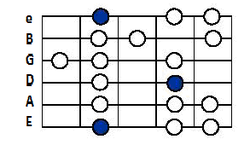ACOUSTIC GUITAR MINOR SCALES
Now we are moving into a different kind of scale. We talked about major scales in the previous lesson, now we are moving into minor scales. Minor and major scales are very similar. The only thing that is different is that the consist of different whole or half steps. A half step is changing the pitch up or down half a degree. For example F to F#. While a whole step is changing from a C to a D. Now there are a few exceptions to this rule. E and B do not have a #. So it goes straight from B to C and straight from E to F. So for a C major scale you have the notes C D E F G A and B. So that would be a C (whole step) D (whole step) E (half step!) F (whole step) G (whole step) A (whole step) B (half step!) and back to C. So to make it short you have W W H W W W H. Now for a minor scale, lets take for example a C minor scale. You have a C D Eb (E flat) F G Ab Bb and back to C. So that would be a C (whole step) D (half step!) Eb (whole step) F (whole step) G (half step!) Ab (whole step) Bb (half step) and back to C. To make it short you have W H W W H W H . So the difference is that a minor has 3 half steps compared to a major's 2. The image above shows the pattern for a minor scale. This is also a movable pattern so you can play this scale anywhere on the neck if you just change the root or first note. Practice going down and up the scale until you are comfortable, then try different keys. This concludes the minor scale lesson.
Thanks for visiting Asound Academy!
This was the minor scale lesson. To move forward, open the interval lesson.
Thanks for visiting Asound Academy!
This was the minor scale lesson. To move forward, open the interval lesson.

